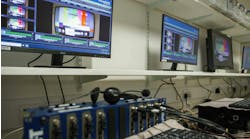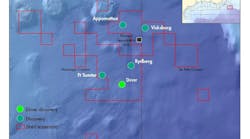Hydro awards subsea work
Hydro has awarded Aker Kværner a Nkr265 million contract for reconstruction of the Troll C platform to produce oil from the satellite Fram East field.
Kværner Oilfield Products (KOP) will deliver the subsea installations for Fram East, where the subsea components will be installed in 360 m of water.
The field layout comprises five oil-producing wells on the seabed and two wells for water injection on Fram East. Oil will be piped for approximately 19 km to Troll C for processing. Production on Fram East is scheduled to start in October 2006.
Aker Kværner Offshore Partner will manage the reconstruction project. It is the third modification contract in the last three months that Hydro has awarded to the company. The first two were for the Oseberg Field Centre and Oseberg East. Total value of the three contracts amounts to Nkr500 million.
Aker Kværner Elektro is responsible for the electro, instrument, and telecommunication work in connection with the modifications on Troll C.
2H Offshore to design riser monitor system
BP has awarded 2H Offshore Engineering Ltd., an Acteon company, a contract to design and supply a monitoring and response evaluation system for the drilling riser on the oil company’s Thunder Horse prospect in 1,800 m of water in the Gulf of Mexico. The riser will be deployed by Transocean’ dual activity drillshipDiscoverer Enterprise.
The monitoring system, to be installed in September, will provide structural response information along the entire riser length in real time to confirm its structural integrity and support drilling operations.
One of the goals of the project is to aid understanding of the behavior of deepwater risers subject to high marine currents, particularly where vortex-induced vibration is a factor. It builds on previous monitoring campaigns conducted by 2H that have used stand-alone instruments recording response data into memory.
The monitoring system will provide data at the surface in real time and give the clearest information yet on the complex problem of VIV response and its associated fatigue damage. The data collected will also greatly assist offshore operations, allow inspection requirements to be optimized, and reduce the risks that are inherent in such operations. It will also provide valuable input to the design of future riser systems.
The monitoring system is expected to work for 20 years and based on experience, the riser is expected to be deployed and retrieved about five times a year. A major practical challenge will be to design the monitoring system so that it can be run without disrupting drilling operations.
The system proposed by 2H is based on self-contained motion monitors capable of capturing very small movements of the riser. Similar devices have been supplied to several operators over the last five years - in fact, there have been over 250 monitors deployed to date.
Key features of the motion monitors are their compactness, low power requirement, and high reliability - 99.9% in recent applications. The monitors on theDiscoverer Enterprise riser will include sensors to measure triaxial acceleration and two-plane angular rate.
Up to 30 monitors will be attached at intervals along the riser. Rather than logging the data locally for post-processing, as has been the case in most previous applications, the monitors connect into an umbilical leading to the surface. Data will be collected constantly and processed immediately. From this information, engineers will be able to calculate riser fatigue damage rates.
Oceaneering buys ROV technology
Oceaneering International Inc. has acquired SpiderBOT Remotely Operated Vehicle technology and assets from Dark Matter LLC. The technology enables completion of unique subsea missions using small ROVs, which achieved notoriety for conducting highly successful interior surveys and high-resolution film documentation of theTitanicand Bismarckshipwrecks in water depths of nearly 3 mi.
Advanced onboard systems enable complex operations in water depths to 20,000 ft. Unlike most ROVs, power is provided onboard using a high energy density battery system. A small diameter, expendable fiber-optic tether deployed from a SpiderBOT ROV provides command and control while supplying feedback to the operator of real-time high-resolution video images and status of onboard system health. These ROVs have demonstrated an unequalled ability to penetrate confined spaces because of their small size and proprietary maneuvering systems.
“We are particularly enthusiastic about the capabilities offered by this new technology,” Duncan McLean, vice president and general manager of Oceaneering Technologies, says. “It will complement Oceaneering’s larger work class ROVs and minimize their exposure to damage during difficult subsea operations. We expect to provide expanded ROV services with the SpiderBOT ROVs to both our oilfield and government customers, such as close-in inspection of subsea equipment, improved search and recovery operations, documentation of shipwrecks, and security inspections of vessels and piers.”
Mooring record
InterMoor Inc., an Acteon company, participated in setting a world record for a conventional mooring system in the offshore Sabah, East Malaysia, Todak-1 exploration well.
The deepest leg of the 8-leg conventional mooring system reached 7,086 ft. Five legs extended to water depths greater than 6,300 ft. InterMoor was working for Murphy Sabah Oil Co. to moor Diamond Offshore’sOcean Rover semisubmersible.
InterMoor provided engineering, planning, and on-site consultation support, as well as writing the mooring deployment procedures. Water depth at the wellhead is 5,890 ft.
Each mooring leg, deployed using the anchor-handling vesselsMaersk Beater and Maersk Supporter, consisted of a 10-metric-ton Stevpris anchor with the rig’s self-contained wire and chain.
Acteon, a group of specialist engineering companies serving the global oil and gas industry, was formerly known as UWG Group. InterMoor evolved from Acteon’s asset acquisition of Technip Offshore Moorings Inc.




